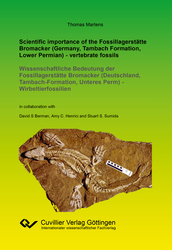| Areas | |
|---|---|
| Serie de libros (96) |
1378
|
| Nachhaltigkeit |
3
|
| Gesundheitswesen |
1
|
| Letra |
2364
|
| Ciencias Naturales |
5406
|
| Matemática | 229 |
| Informática | 319 |
| Física | 980 |
| Química | 1363 |
| Geociencias | 131 |
| Medicina humana | 243 |
| Estomatología | 10 |
| Veterinaria | 108 |
| Farmacia | 147 |
| Biología | 835 |
| Bioquímica, biología molecular, tecnología genética | 121 |
| Biofísica | 25 |
| Nutrición | 45 |
| Agricultura | 1004 |
| Silvicultura | 201 |
| Horticultura | 20 |
| Ecología y conservación de la tierra | 148 |
| Ciencias Ingeniería |
1793
|
| General |
98
|
|
Leitlinien Unfallchirurgie
5. Auflage bestellen |
|
Erweiterte Suche
Scientific importance of the Fossillagerstätte Bromacker (Germany, Tambach Formation, Lower Permian) - vertebrate fossils (Tienda española)
Wissenschaftliche Bedeutung der Fossillagerstätte Bromacker (Deutschland, Tambach-Formation, Unteres Perm) - Wirbeltierfossilien
Thomas Martens (Autor)Previo
Lectura de prueba, PDF (1,4 MB)
Indice, PDF (16 KB)
Unsere Erkenntnisse von der Evolution der frühen, terrestrisch angepassten Reptilien und Amphibien während einer Zeitspanne von vor 320 bis 270 Millionen Jahren auf dem Superkontinent Pangäa sind nur von einer sehr begrenzten Anzahl von Fossilfundstellen bekannt. Die meisten davon liegen in Nordamerika. Die Fossilfundstätte Bromacker in der unterpermischen Tambach-Formation bei Tambach-Dietharz (Deutschland) hat sich während der letzten 25 Jahre mit 11 neuen Arten zur bedeutendsten und produktivsten Fossillagerstätte für unterpermische, terrestrisch angepasste Wirbeltiere außerhalb der USA entwickelt. Der Bromacker enthält die besterhaltenen, terrestrischen Wirbeltierfossilien aus dem Unteren Perm (etwa vor 290 Millionen Jahren). Die Diversität der Fossilien bedeutet, dass der Bromacker das einzige gut dokumentierte Beispiel eines frühen terrestrischen Ökosystems repräsentiert. Das Buch enthält erstmals einen Überblick der Bedeutung des Bromackers mit zahlreichen Fossilabbildungen.
Our understanding of the evolution of the earliest terrestrially adapted reptiles and amphibians during the time span 320 to 270 million years ago on the Pangaea supercontinent is known from only very restricted types of fossil localities, most of which are in North America. The fossil locality Bromacker in the Lower Permian Tambach Formation near Tambach-Dietharz (Germany) has developed during the last 25 years with 11 new species to be the most important and productive fossil locality for Lower Permian, terrestrially adapted vertebrates outside USA. The Bromacker locality produces the best preserved terrestrial vertebrate fossils from the Lower Permian time period (about 290 million years ago). The diversity of the fossils indicates that it represents the only fully documented example of an initial stage in the evolution of the modern terrestrial vertebrate ecosystem. The book contains first overview about the importance of the Bromacker with lot of fossil illustrations.
| ISBN-13 (Impresion) | 9783736997455 |
| ISBN-13 (E-Book) | 9783736987456 |
| Formato | A5 |
| Idioma | Inglés, Alemán |
| Numero de paginas | 52 |
| Laminacion de la cubierta | Brillante |
| Edicion | 1. |
| Lugar de publicacion | Göttingen |
| Fecha de publicacion | 15.03.2018 |
| Clasificacion simple | Libro de divulgacion |
| Area |
Geociencias
|
| Palabras claves | Geowissenschaften, Paläontologie, Wirbeltierfossilien, Lokalität Bromacker, Tambach-Dietharz, Thüringer Wald |
| URL para pagina web externa | https://www.ursaurier.de/ |








